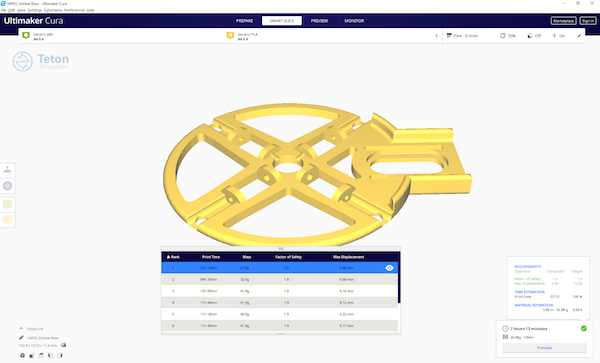
This image shows the results of the Optimize feature of Teton Smart Slice. The solution provides the user with a table of print setting configurations that meet their design requirements (minimum factor of safety and maximum displacement) for the use case they have defined. The user can select any configuration from the table, slice it, and then print it. Image courtesy of Teton.
Latest News
September 17, 2020
After four years of development, Teton Simulation Software has officially launched its Smart Slice for Ultimaker Essentials simulation tool for optimizing 3D printer performance. Initially, the product is launching in Ultimaker's Cura Essentials Marketplace. The product currently works for FFF 3D printing for plastics and polymers, but other variations are in the works.
According to the company, the solution was created to reduce uncertainty around part performance in the fused-filament fabrication (FFF) additive manufacturing process. Because a number of factors can influence print quality, end users typically have to perform numerous build-and-break iterations, which wastes material and increases print times.
Smart Slice optimizes print settings, which reduces both cost and waste. The subscription-based software is integrated into Ultimaker’s Cura Enterprise and built on Teton's cloud technology.
Smart Slice uses FEA analysis within the slicing environment to automatically provide optimal strengthening settings for a given print, eliminating the need to iteratively test actual prints. The tool validates a print configuration in advance, adjusts the slicing parameters that can influence part strength, and then provides that data so the final print can be completed.
“We are addressing an acute problem that is focused on the number of senseless iterations that happen between building a model, testing it to see if it will work, and then running that over and over again on the printer until we get it right,” says Teton CEO Mike Kmetz.
“No one knows how to design for FFF,” says Doug Kenik, vice president of product at Teton. “What is the structural integrity of the part that will come out on the other end? That's what we've honed in on. Manually iterating, even in software, is not ideal. We use an optimization algorithm to evaluate all of the slicer settings in your slicer of choice, and then tell you which ones are best.”
Ideally, all of that information would be in the CAD system, but end users often don't have access to CAD or don't know how to use it very well. Smart Slice provides a bridge to optimize the machine settings for producing the part prior to manufacturing. The solution is a plug-in for the slicer and can work with any STL files.
The product is being rolled out jointly with Ultimaker, as Teton took advantage of the open source capabilities of Cura.
“Teton's Smart Slice brings engineering grade part simulation to Cura as an exclusive marketplace plugin for Ultimaker Essentials users. Using the integration options of our open and pluggable platform it will make sure parts still meet their engineering criteria, but need less material and therefore saving valuable time and costs. The cooperation with Teton and the integration of their innovative solution are a prime example of how we will be continuously adding value for our professional customers.” says Paul Heijmans, senior VP of software at Ultimaker.
According to Kenik, Teton believes that Smart Slice can reduce the number of print iterations required to obtain a good part. “Traditionally we've seen anywhere from 5 to 50 iterations for a part. We think we can take that down to two, which can save hundreds of hours.”
“If a company is printing a low-volume, say ten parts, and we save them 30 percent in terms of part time, if you spread that over ten parts, it adds up in no time,” Kmetz says. “The company will also offer a cost estimator as part of the product launch.”
According to the company, the product is easy to use and provides fast results. Additionally, Smart Slice can automatically optimize parameters so a user can “identify the settings that yield the fastest print by minimizing time and material while meeting performance requirements.”
“Our Smart Slice technology was built from the ground up to give 3D printer operators near instant feedback on the viability of their project. There is simply no other solution in the industry that can provide lightning-fast, accurate feedback on the ‘as printed’ state of a part. Plus, our optimization feature takes the guesswork out of determining the right slicing parameters. We do all the work, so the user doesn’t have to. All of this capability is provided within the slicer making it very easy to use,” Kmetz says.
A 30-day free trial of Smart Slice is available. Introductory annual subscription rates are also available.
Subscribe to our FREE magazine, FREE email newsletters or both!
Latest News
About the Author
Brian Albright is the editorial director of Digital Engineering. Contact him at de-editors@digitaleng.news.
Follow DE





